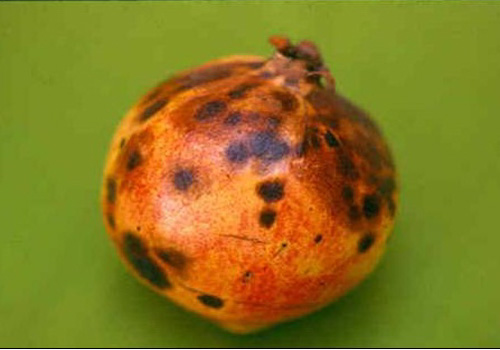|

Symptoms:
The
disease manifest in various form of symptoms causing
leaf blight, fruit spot, wither tip, die back and fruit
rotting as described below:
(i)
Leaf blight:
The disease starts as minute, dull violet black or black
spots surrounded by yellow necrotic areas. The spots
enlarge; coalesce to form depressed large spots of
aniline black in color. Severely infected leaves show
necrotic areas extending from leaf margins to cover
whole leaf blade. Leaves show curling at some points and
severely infected leaves, become dry and fall off.
Sometimes shot hole stage is also observed.
(ii) Fruit spots:
The pomegranate fruits are highly susceptible to attack
by this pathogen from early stages of development
(flower bud stage - (Reddish) and fruit enlargement
stage before attaining greenish color and subsequently
at color breaking stage. Smaller brownish spots, which
become depressed subsequently, increase in size to form
the large spots. During greenish stage of fruit
development infection remains quiescent and exhibit
symptoms at color breaking stage. Mature fruits show
numerous brownish black depressed spots, which coalesced
to form bigger patch. The entire infected portion
changes color to yellowish brown and fruits start
rotting which becomes serious during storage. Severe
infection of fruits results in flower bud and fruit drop
and in mummified fruit and at times cause rupture of the
fruit exocarp also.
(iii) Wither tip and die back:
Younger, developing shoot tips are killed due to attack
of pathogen and some developing
branches show drying from the tips backward with
necrotic areas extending downwards, such branches become
dry and devoid of foliage subsequently and give die back
appearance. These symptoms are more pronounced in older
trees and neglected orchards.
Managemnt :
For the disease management, prune the dried twigs and
branches and burn them. After pruning a general spray of
copper oxychloride (Blitox 0.3%) and pasting of cut ends
with copper fungicide should be practiced. Subsequently
spraying with hexaconazole (Contaf 0.1%) or carbendazim
(Bavistin 0.1%) or thiophanate methyl (Topsin M or Roko
0.1%) should be given. First spray at flower bud stage
and subsequently 5 – 6 sprays at the interval of 7-10
days interval have to be provided. Chlorothalonil
(Kavach 0.2%) or mancozeb (IndofilDithane M 0.2%) in
non-systemic category also control the disease.
|